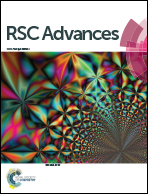Bimetallic phosphide decorated Mo–BiVO4 for significantly improved photoelectrochemical activity and stability†
Abstract
Bismuth vanadate photoanode has shown great potential for photoelectrochemical (PEC) catalysis, but it needs to be further modified because of its relatively low charge-separation efficiency and poor stability. Herein, the bimetallic phosphide NiCoP decorated Mo–BiVO4 is fabricated through the electrodeposition and drop-casting method, which significantly improves the charge separation and surface oxidation reaction. Therefore, the fabricated NiCoP/Mo–BiVO4 photoanode exhibits a low onset potential of 0.21 V (vs. RHE) and high photocurrent of 3.21 mA cm−2 at 1.23 V (vs. RHE), which is 3.12 times higher than that of pure BiVO4. Importantly, the decoration of NiCoP significantly improve the stability of BiVO4 photoanode.



 Please wait while we load your content...
Please wait while we load your content...